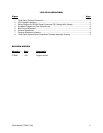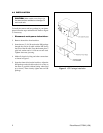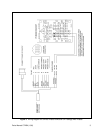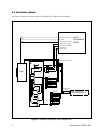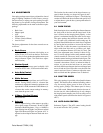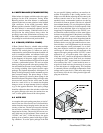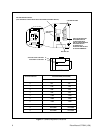
6 Pelco Manual C720M (1/96)
6.4 WHITE BALANCE (ATW/AWB SWITCH)
White balance is a feature available on the color optics
packages. In the ATW (Automatic Tracing White
Balance) position, the white balance is continuously
adjusted to take into account variations in the incident
light conditions. In the AWB (Automatic White
Balance) position, when the “LOCK” button is pressed,
the white balance is automatically adjusted, and the
setting is stored in memory. When the switch is set to
this position the white balance always takes the
previously stored value. White balance is factory set to
the AWB position and it is recommended that the op-
tics package be used in the mode just described.
6.5 V-PHASE (VERTICAL PHASE)
V-Phase (Vertical Phase) is valuable when multiple
optic packages are switched by a sequential or matrix
switcher. The vertical phase +/- buttons are used to
compensate for vertical phase discrepancies which will
occur in a multiple camera environment. In this type
of environment, each cameras output is synchronized
by the frequency of the power supply and phase. The
“+” and “-” buttons referenced in Figure 6 can be used
to obtain a synchronized picture. The user can adjust
them by placing one person at the optics package loca-
tion and another at the control room looking at a moni-
tor viewing switching video signals from the optics
packages. The V-phase adjustment is ±90 degrees. Use
the tip of a ball-point pen or similar instrument to press
these recessed buttons. The phase change is linear.
Pressing a button will activate a phase change in the
direction indicated. The phase change will begin after
about one-half second, but the switch must be held
down for a total of five or six seconds for the phase
change to occur. An equal amount of time is required
to go in the opposite direction. Each optics package
should be adjusted so that as the switchers switch from
one optics package to the next, the monitor does not
“roll” or show partial frames of the video picture.
6.6 AUTO IRIS
As an option, this optics package may have an “active”
auto iris lens. An active auto iris lens is fed back infor-
mation from the camera imaging head to the auto iris
circuitry of the lens. The lens processes this informa-
tion and tries to maintain a constant light level to the
image head at all times. The auto iris lens has two con-
trols which may be field adjusted. These controls are
“LEVEL” and “ALC”. From the factory, the optics
package is set to handle a general wide range of light-
ing conditions. To set the optics package in the field Figure 5. Back Focus Adjustment
for your specific lighting condition, you must first de-
termine if the picture on the viewing monitor is too
bright or too dim. Before adjusting the Iris controls, the
monitor controls must be set at their “detente” (or
notched) factory recommended positions (not having
all controls for contrast, picture, color, tint, etc. adjusted
for maximum intensity). If a very dim picture is present,
this would indicate that the iris could be opened a little
more to allow additional light to be imposed on the
image head. To brighten the picture, the “LEVEL” con-
trol should be rotated clockwise to allow more light to
be shown on the image head. If the picture is too bright,
rotating the “LEVEL” control counterclockwise will
allow less light to be shown on the image head and the
picture on the monitor will become dimmer. If the in-
stallation site has varying light conditions due to store-
front windows, several adjustments may be necessary
to ensure adequate overall performance. As an alter-
nate (more objective) method of adjusting the iris, an
oscilloscope or video meter may be connected to the
output of the optics package and the “LEVEL” control
adjusted for a 1 volt peak-to-peak video signal out.
Lastly, the “ALC” control can be adjusted to either Peak
or Average sampling levels. Peak levels are obtained
by rotating the “ALC” control clockwise. Counterclock-
wise rotation of the “ALC” control results in more av-
erage levels. Peak levels may be necessary if you want
to view dark objects in a bright setting. This condition
is commonly known as backlight compensation. Peak
settings tend to open the iris a little more and average
levels tend to close the iris a little given the light sam-
pling rate of the lens.





